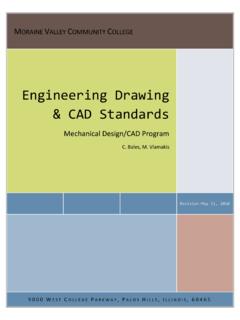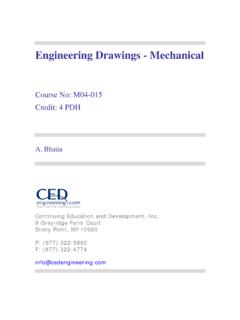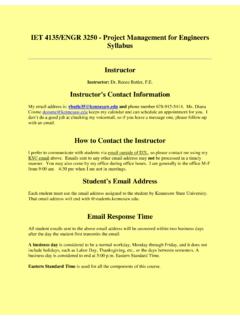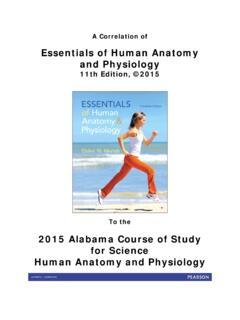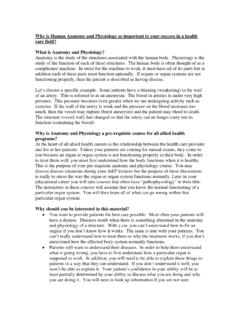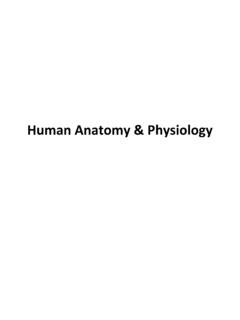Transcription of BIOLOGY 2221 – Human Anatomy and Physiology I
1 BIOLOGY 2221 Human Anatomy and Physiology I Summer 2010 Instructor: Scott Reese, Lecture Room: SCI 109 Office: SC 323 Lecture Time: M W 0800-10:45 AM Office Hours: T 9:00 11:00 AM Office Phone: 770-423-6168 Skype: doctor_reese e-mail: URL: ~sreese3 TENTATIVE SCHEDULE1 Date Topic Text2 W. 26 May Introduction & Human Body Orientation Chap. 1 M. 31 May Memorial Day-No Class W. 02 Jun. Beginning Chemistry Chap. 2 M. 07 Jun. Quiz 1 Beginning Chemistry & Cells Chaps. 2 & 3 W. 09 Jun. Cells Chap. 3 M. 14 Jun. Quiz 2 Tissues Chap. 4 W. 16 Jun. Exam I Integumentary System Chaps. 1, 2, 3, & 4 Chap. 5 M. 21 Jun. Quiz 3 Skeletal System Chaps. 6 & 7 W. 23 Jun. Skeletal System Chaps. 7 & 8 M.
2 28 Jun. Quiz 4 Neurons Chap. 11 W. 30 Jun. Exam II Central Nervous System Chaps 5, 6, 7, 8, & 11 Chap. 12 M. 05 Jul. 4th of July-No Class W. 07 Jul. Central Nervous System Quiz 5 Peripheral Nervous System Chap. 12 Chap. 13 M. 12 Jul. Autonomic Nervous System Chap. 14 W. 14 Jul. Quiz 6 Special Senses Chap. 15 M. 19 Jul. Exam III Muscles Chaps 12, 13, 14, & 15 Chaps. 9 & 10 W. 21 Jul. Quiz 7 Muscles Chaps. 9 & 10 M. 26 Jul. Final Exam Cumulative & Chaps 9 & 10 1 Please be aware that this schedule is tentative. 2 Text Book: Marieb, E. N. 2004. Human Anatomy & Physiology . 7th Ed. Pearson/Benjamin Cummings, San Francisco, CA. COURSE DESCRIPTION BIOL 2221. Human Anatomy and Physiology . 3-0-3. Corequisite: CHEM 1151 and CHEM 1151L or SCI 1101. The course begins with cellular chemistry and function, tissues, and continues through the nervous, skeletal, and muscular systems. Homeostasis, structural, and functional relationships will be emphasized.
3 Primarily recommended for students interested in nursing, physical therapy and health, physical education and sports science. Cannot be used for credit toward a degree in BIOLOGY , nor is it applicable to the general education (core) requirements of this university. COURSE PHILOSOPHY Human Anatomy and Physiology is an introduction into the structure and function of the Human animal. Anatomical and physiological systems have evolved to a very complex state in mammals and that means there will be a large amount of material presented quite rapidly during this course. It is essential that students do not fall behind in this material as it will be difficult (to the extreme) to catch up. The lectures will focus on functional aspects utilizing the concept of homeostasis to link Anatomy to its concomitant Physiology . There will be large components of memorization to deal with anatomical terminology, but it is important to be able to link these terms into a conceptual framework.
4 Lectures will focus on giving students that framework, but it is imperative that students do not forget about the details that will be important for understanding physiological concepts. This class will integrate lots of scientific principles from fields as diverse as physics and chemistry to try and understand the evolutionary results for the modern physiological and anatomical systems in the Human animal. COURSE LEARNING OUTCOMES 1. Terminology: Students will be able a. Define appropriate terminology to effectively communicate information related to Anatomy and Physiology . 2. Structure & Function 1: Students will be able a. Recognize the anatomical structures and b. Explain the physiological functions of body systems. 3. Homeostatic Control: Students will be able a. Recognize and explain the principle of homeostasis and the mechanisms used to control physiological systems in the Human body. 4. Structure & Function 2: Students will be able a.
5 Explain how anatomical relationships apply to physiological functions. 5. Systems Integration: Students will be able a. Recognize and explain the interrelationships within and between anatomical and physiological systems of the Human body. 6. Life Applications: Students will be able a. Recognize connections between knowledge of Anatomy / Physiology and real-world situations, including healthy lifestyle decisions and homeostatic imbalances. 7. Experimental Techniques: Students will be able a. Demonstrate laboratory procedures used to examine anatomical structures and b. Evaluate physiological functions of each organ system. 8. Quantitative Reasoning: Students will be able a. Use quantitative reasoning to interpret anatomical and physiological graphs and data. COURSE POLICIES Participation: Class attendance and participation is required to succeed. Each day during lecture (placed randomly by me) I will give out a password that students can use to access the assignment for that material on WebCT Vista.
6 It is a once-a-lecture event, if you are not there when I give out the password, you do not get that one for the exceptions. You will then have 24 h from that lecture to complete the assignment. Your score for this part of the course will be determined by your successful completion of these assignments. You are NOT allowed to give the day s password to your classmates. If I discover that you have done so, I will start academic misconduct proceedings and give you both a 0 for this part of the course. If you miss a lecture, it is your responsibility to obtain lecture notes from a classmate; my notes will not be made available to students. Please arrive before the beginning of lecture so as not to disturb your fellow students. You are encouraged to ask questions during lecture. Turn off all cell phones, pagers, etc. Examinations and Grades: There are three examinations scheduled during the semester along with a final exam. Each exam will be over the material covered in the lectures and readings.
7 A detailed look at the material for each exam can be found in the chapter learning outcomes on the A&P website. Whether covered in lecture or not, you are responsible for everything found in the chapter outcomes. The final exam will be cumulative, although there will be some new material. You must take all exams on the date offered. If you are unable to take the exam on the given date, you must have an acceptable reason (these need to be dire situations, not just your buddies party was the night before) and you must contact me before the day of the exam. An email is fine, though special effort should be made to speak to me directly. If I find your excuse acceptable (and you better have a good document trail), then your exam will be forfeited and whatever you achieve on the cumulative portion of the final will substitute for this score. Please be advised, you do not want to make the final weighted this heavy except in the direst of circumstances. If you miss an exam without an acceptable excuse, documentation, or without having contacted me before, you will receive the grade of 0 (zero) for that exam.
8 You must take the final exam to receive credit for this course. If I decide to change the point totals for the course, you will be notified verbally and/or via the course web site. If you receive 50% or less of the points on the first exam, please talk to me. Such a score indicates that you are having trouble in this class and you may need to consider withdrawing. Quizzes There are 7 required quizzes and they will be administered through WebCT Vista. The quizzes will become active 24 hours before the lecture they are due and will cut off at 8 AM on the day of the lecture. The material covered for the quiz will be for the material that will be covered in the coming lectures (yes that means you must pre-read the chapters). Once you begin the quiz on WebCT, you will have exactly 15 minutes to complete 10 multiple choice questions. You are not allowed to use other students, the text, or notes to take the quiz. I cannot monitor this activity, but if I determine someone to be cheating, they will lose all of these points.
9 In addition, the length of the quiz means that you will have minutes to answer each question, which is an awfully short time to try and look up the answer during the quiz. You must answer 7 of the 10 questions correctly to get credit for a particular quiz. You will get 3, and only 3, attempts at each quiz. If you complete minimally 6 of the 7 quizzes you will get full credit (22 pts or 5 % of the total course score) for this activity. If you complete 5 of the 7 quizzes you will get half credit (11 pts) Anything less than 5 and you will get none of these points. The grading procedure for this course is as follows: Exam I 100 pts. ( %) Exam II 100 pts. ( %) Exam III 100 pts. ( %) Final Exam 100 pts. ( %) Participation 22 pts. (5 %) Quizzes 22 pts. (5 %) Total 444 pts. (100 %) Your grade for this course will be based on the following point distribution: A=397-444 pts.; B=353-396 pts.; C=309-352 pts.; D=264-308 pts.; F 263 pts. There is no extra-credit.
10 " The final grading scale may be adjusted at the discretion of the instructor. It should be noted that dates and total points are subject to change if there are circumstances, deemed by me, to be extenuating. You will be given verbal notification of any changes in class and/or it will be posted under Announcements on the course web site (URL: ). Accommodations: Any student with a documented disability or medical condition needing academic accommodations of class-related activities or schedules must contact the instructor immediately. Written verification from the KSU disAbled Student Support Services is required. No requirements exist that accommodations be made prior to completion of this approved University documentation. All discussions will remain confidential. Academic Honesty: Every KSU student is responsible for upholding the provisions of the Student Code of Conduct, as published in the Undergraduate and Graduate Catalogs. Section II of the Student Code of Conduct addresses the University's policy on academic honesty, including provisions regarding plagiarism and cheating, unauthorized access to University materials, misrepresentation/falsification of University records or academic work, malicious removal, retention, or destruction of library materials, malicious/intentional misuse of computer facilities and/or services, and misuse of student identification cards.
